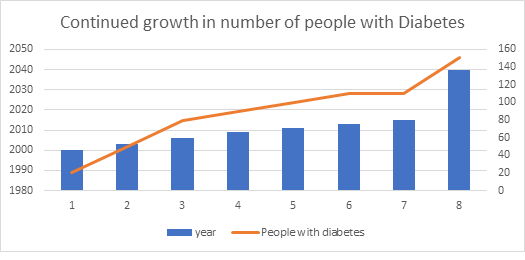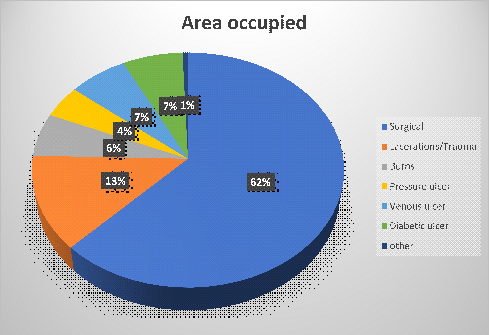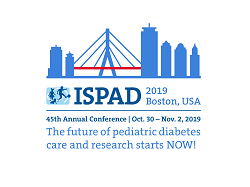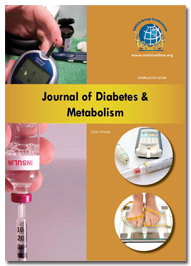Theme: Commitment to Excellence in the field of Diabetes and Endocrinology
Endocrinology Meet 2019
About Endocrinology Meet 2019:
ME Conferences officially welcomes you to attend Conference on 2nd Global Meeting on Diabetes and Endocrinology going to be held during May 30-31, 2019 in Istanbul, Turkey. Endocrinology Meet 2019 conference will focus on the latest and exciting innovations in all areas of Endocrinology research offering a unique opportunity for investigators across the globe to meet, network, and perceive new scientific innovations
Diabetes and Endocrinology 2019 provides two days robust discussions on methods and strategies related to diagnosis, prevention and management of endocrinal diseases as well as explore new ideas and concepts on a global scale and the topics include Diabetic Disorders and Treatment, Current Advances in Endocrinology & Metabolism, Thyroid Gland and its Disorders, Reproductive Endocrinology, Energy Balance and Obesity, Treatment and Diagnosis of Endocrine Diseases, Surgery. The conference invites Endocrine surgeons, diabetologists, Reproductive Endocrinologists and all the eminent researchers and experts in the field of Endocrinal medicine. The conference also welcomes the participation of Presidents, CEO’s, Delegates and industrial executives from Endocrine Pharma and Health care sectors making the conference a perfect platform to network, share views and knowledge through interactive keynote, plenary, poster and B2B discussions.
ME Conferences Organizes 300+ Conferences every year across USA, Europe & Asia with support from 1000 more scientific societies and Publishes 500+ Open access journals which contains over 30000 eminent personalities, reputed scientists as editorial board members.
In United States alone, more than 50,000 people die every year. Nearly 200000 people are treated annually for type-1 and type-2 diabetes every year. The global endocrinal healthcare market touches around $2.03 billion. Endocrinal associations are being funded annually about $212,286 million to $407,716 million for endocrinal research.
Istanbul, Turkey Endocrinology conference will focus on the latest and exciting innovations in all areas of Endocrinology research offering a unique opportunity for investigators across the globe to meet, network, and perceive new scientific innovations. ME conferences officially welcomes you to attend Conference on 2nd Global Meeting on Diabetes and Endocrinology during May 30-31, 2019 at Istanbul, Turkey. Endocrinology Meet 2019 conference will focus on the latest and exciting innovations in all areas of Endocrinology research offering a unique opportunity for investigators across the globe to meet, network, and perceive new scientific innovations.
Track 1: Diabetes and Cancer
Studies for the combination of cancer and diabetes have been conducted over a period of years. Both the diseases are very complex, and they are distinguished very categorically. Cancers that generally occur in the Diabetic patients are liver, pancreas, and bladder.
Worldwide cancer is the 2nd while Diabetes is the 12th leading cause of death in humans. In the U. S, the prevalence of diabetes in the year 2015 was10.5%. Results of some studies suggest that diabetes may increase the mortality of patients suffering from cancer. Risk factors are common in both cancer and diabetes patients which includes aging, obesity, sex, diet, alcohol, and smoking.
Track 2: Diabetic Nephropathy
Diabetic nephropathy is the disease/ damaged caused by diabetes to your kidney, which in severe cases can lead to kidney failure. The waste from our blood is filtered by the tiny blood vessels present in our kidney, they can be destroyed by high blood sugar level in our body. The body retains excess water and salts than required leading to weight gain and ankle swelling. This leads to malfunction or kidney failure in later stages. No symptoms are shown in earlier stages so, regular urine tests are required to detect any kidney damage.
Diabetes may also lead to damage to nerves, which can lead to difficulty in emptying your bladder and creating pressure injuring your kidney. Long time retention of urine in bladder leads to infections as bacterial growth in urine with high blood sugar level is high.
About 30% of patients with Type 1 diabetes and 10 to 40 % of those with Type 2 diabetes gradually will suffer from kidney failure.
Track 3: Diabetes Ophthalmology
Diabetic retinopathy is caused due to damage to the blood vessels in the tissue of retina. Poor control of blood sugar is one of the risk factors. The blood vessels may swell and leak fluid and abnormal development of new blood vessels on the surface of the retina is seen. The accompanying scar tissue might contract and detach from retina.
Symptoms in initial stages include floaters, blurriness, dark areas of vision and difficulty perceiving colors. There is no cure for diabetic retinopathy but can be treated laser treatments for and surgical removal of vitreous gel (vitrectomy) for better vision.
Track 4: Diabetes & Dental Health
Individuals with diabetes have more critical issues with teeth and gum, so great care is necessary. Periodontal disease is a common dental problem seen in individuals with diabetes. Risk of gum problems is more in aging people and with poor blood sugar maintenance. With infections and gum issues the blood sugar levels increase and makes it harder to control diabetes due to less susceptible to bacteria infecting the gums.
Track 5: Diabetes and Skin complication
Diabetes can affect any part of the body including skin. It sometimes helps in recognizing persons with diabetes earlier. Most of the skin conditions can be easily treated. The skin problems are simple but easily prone by diabetic person. Other skin problem like diabetic dermopathy, necrobiosis lipoidica diabeticorum, diabetic blisters, and eruptive xanthomatosis are mostly likely affected in diabetic persons only.
Track 6: Diabetes and Cardiovascular Diseases
Adults with diabetes are more prone to cardiovascular complication (6% of the individuals) like atherosclerosis which narrow the arteries and leads to reduced blood flow to the heart and other body parts. The partial blockage of the coronary arteries produces angina (chest pain) and the complete blockage lead to heart attack. Atherosclerosis also leads to stoke the complete blockage of blood flow to brain and peripheral arterial disease – poor supply of blood to the legs. These are the main reasons for the death of most people with diabetes.
Track 7: Diet and Weight Management
Maintaining a proper diet is very essential in diabetic patients in order to reduce the risk of diabetic complications. A healthy eating pattern and proper physical activity is the key component. Generally low carbohydrate is insisted as these are macronutrients which raises the blood glucose levels, high fiber diet is preferred, foods like whole grains, vegetables, fruits, and nuts, low fat food are best source. Some of the methods for healthy diet plan are Glycemic index, carbohydrate counting, the My Plate method, and the TLC diet plan
Weight management is a key to a healthy lifestyle.
Track 8: Obesity Complication and Management
Obesity is one of the risk factors in development of insulin resistance which are compensated by pancreatic beta cells for insulin resistance by augmenting insulin secretion and the failure of beta cells is believed to cause pre-diabetes which leads to diabetes. Changes of developing type-2 diabetes is high in overweight people.
Fat tissues produces hormones which effect the cell growth and leads to cancer. Obesity in children is seen mainly due to early onset of puberty, menstrual irregularities during adolescence and polycystic ovary syndrome, it can be prevented by choosing healthy diet and regular physical activity.
Women with high BMI’s have high risk of ovulatory problems and response poorly to fertility treatment
Track 9: Neuro Endocrinology
Neuroendocrinology is the study of interaction between nervous system and endocrine system which regulate physiological process in our body. Hypothalamus maintains homeostasis, regulating reproduction, metabolism, osmolarity and blood pressure in our body with the help of neuroendocrine system. Neuroendocrine cancer is a malignant tumor starting in neuroendocrine cells. These tumors are commonly occurred in intestine called carcinoma tumors. Pancreatic neuroendocrine cancer forms in islet cells. Symptoms may or may not be shown.
Track 10: Diabetic Foot and Ankle
Diabetic patients should monitor their feet regularly to avoid risks which may lead amputation. Even minor wounds like blister to foot lead to serious consequences, as blood flow decreases in diabetic person the wound healing is delayed leading to infection and spread of infection quickly. Predominant pathogens include gram +ve cocci especially staphylococci and streptococci. Chronic or previously treated wounds lead to several microbial cultures for which appropriate antimicrobial therapy is required.
Track 11: Pediatric Diabetes
Pediatric diabetes is a condition is children dealing with endocrine disorders like physical growth and sexual development and diabetes. In pediatric type 1 diabetes the body loses its ability to produce insulin due to autoimmune destruction of beta cells and most of the pediatric patients with diabetes have type 1 diabetes depending lifelong on exogenous insulin. Children are diagnosed with type 1 diabetes are mostly obese and with type 2 are at high risk of cardiovascular diseases and microvascular complications.
Track 12: Reproductive Endocrinology
Reproductive endocrinology is a surgical subspecialty of obstetrics and gynecology which trains physician in reproductive filed about hormonal functioning. Pregnancy is a significant stage of a women’s life. It is called as incubation where posterity is created in women so, care should be taken that both the posterity and the women are safe. A pregnant woman and the child are at high risk of thyroid disorder following infertility, miscarriage and complications during pregnancy and labor. Thyroid aliments in women can cause and issue with menstrual period, problem getting pregnant and problem amid pregnancy.
Track 13: Biomarkers for Diabetes
Molecular biomarker is a naturally occurring molecule, gene or a character which helps in identifying the diseases. In case of diabetes HbA1c is considered as a biomarker to identify risk factors for retinopathy, nephropathy and vascular diseases. These provide preventive measures at the subclinical stage. The well organized and usage of biomarker within the growth of anti-diabetes medication can help in better and quick understanding of the pathological process of diabetes.
Track 14: Thyroid Disorders
The small butterfly shaped gland located at the base of the neck at adams apple is called as thyroid. It is a part of the endocrine system, which is responsible to co-ordinate many body’s activities. Thyroid glands produce prohormones which regulate the body’s metabolism. When thyroid produces excess of hormones leading hyperthyroidism and when less hormones are produced leads to hypothyroidism. Thyroid diseases are most likely to affect women than men. In women infertility, miscarriage, menstrual period, problems during pregnancy and childbirth.
Inborn hypothyroidism is a confusion that influences in newborns during childbirth, it occurs due to loos of thyroid capability due to decreased or no growth of the organ.
Graves’ disease is an immune system disorder which leads to excess production of thyroid hormones called as hyperthyroidism. The thyroid hormones metabolism is regulated by protein, fat and carbohydrates.
Track 15: Diabetes Complication and Management
The main aim of diabetes complication and management is to bring the carbohydrate metabolism to normal state. In order to achieve it patients with insulin deficiency are with insulin injections or pumps and patients with insulin resistance are treated with proper diet maintenance and exercise. The other complication caused due to other disease are to be treated or prevented. Maintaining a healthy diet is best to have a healthy living with or without diabetes.
Diabetes is a main factor for cardiovascular disease, development of other secondary conditions. Regular check-ups on blood pressure, cholesterol, LDL, HDL and triglyceride levels, eye examination to prevent diabetic retinopathy, foot care specialist is better to prevent diabetes occurrence.
Diabetes and Endocrinology 2019 provides two days robust discussions on methods and strategies related to diagnosis, prevention and management of endocrinal diseases as well as explore new ideas and concepts on a global scale and the topics include Diabetic Disorders and Treatment, Current Advances in Endocrinology & Metabolism, Thyroid Gland and its Disorders, Reproductive Endocrinology, Energy Balance and Obesity, Treatment and Diagnosis of Endocrine Diseases, Surgery. The conference invites Endocrine surgeons, diabetologists, Reproductive Endocrinologists and all the eminent researchers and experts in the field of Endocrinal medicine. The conference also welcomes the participation of Presidents, CEO’s, Delegates and industrial executives from Endocrine Pharma and Health care sectors making the conference a perfect platform to network, share views and knowledge through interactive keynote, plenary, poster and B2B discussions.
In United States alone, more than 50,000 people die every year. Nearly 200000 people are treated annually for type-1 and type-2 diabetes every year. The global endocrinal healthcare market touches around $2.03 billion. Endocrinal associations are being funded annually about $212,286 million to $407,716 million for endocrinal research.
Istanbul, Turkey Endocrinology conference will focus on the latest and exciting innovations in all areas of Endocrinology research offering a unique opportunity for investigators across the globe to meet, network, and perceive new scientific innovations.
Highlights:
- Diabetes and Cancer
- Diabetic Nephropathy
- Diabetes Ophthalmology
- Diabetes & Dental Health
- Diabetes and Skin complication
- Diabetes and Cardiovascular Diseases
- Diet and Weight Management
- Obesity Complication and Management
- Neuro Endocrinology
- Diabetic Foot and Ankle
- Pediatric Diabetes
- Reproductive Endocrinology
- Biomarkers for Diabetes
- Thyroid Disorders
- Diabetes Complication and Management
Important and scope:
Diabetes reduce the burden of diabetes mellitus (DM) and improve the quality of life for all persons who have or are at risk for diabetes mellitus.
DM affects an estimated 29.1 million people in the United States and is the 7th leading cause of death. It increases the all-cause mortality rate 1.8 times compared to persons without diagnosed diabetes. It Increases the risk of heart attack by 1.8 times, in addition to these human costs, the estimated total financial cost of DM in the United States in 2012 was $245 billion, which includes the costs of medical care, disability, and premature death.
The importance of both diabetes and their comorbidities will continue to increase as the population ages. Therapies that have proven to reduce microvascular and macrovascular complications will need to be assessed considering the newly identified comorbidities.
Why Istanbul ?
Turkey is present in Anatolian region of West Eurasia and associated as an integral part of the Greater Middle East region. It has a very colorful history and the Turkish culture is mix of Ottoman, Greek and western influences.
The nation is surrounded by seas on three sides amidst the Aegean Sea to the west, the Black Sea to the north, and the Mediterranean Sea to the south. The Bosphorus, the Dardanelles, and the Sea of Marmara, which together form the Turkish Straits, divide Thrace and Anatolia and separate Europe and Asia. Ankara is the capital while Istanbul is the country's biggest city and main commercial and cultural centre.
Istanbul is the most populous city in Turkey and the country's economic, cultural, and historic center. Istanbul is one of the world’s greatest city. Istanbul is a transcontinental city in Eurasia straddling the Bosphorus strait which separate Europe from Asia. Once Istanbul was known as by the name of Byzantium then Constantinople. Turkey’s economic, cultural and financial epicenter is also a tourism heavyweight – it was the world’s eighth most visited city in 2016.
Hagia Sophia is a great architectural beauty and an important monument both for Byzantine and for Ottoman Empires. Once a church, later a mosque, and now a museum at the Turkish Republic, Hagia Sophia has always been the precious of its time.
Sultan Ahmed Mosque also The Blue Mosque because of its blue in color. It is still used as a mosque and it is one of the most popular tourist attractions in Istanbul.
Basilica Cistern was built in 532 by Emperor Justinian. It is the largest surviving Byzantine cistern in Istanbul constructed using 336 columns
Topkapı Palace is the largest museum in Istanbul. In the 15th century, it served as the main residence and administrative headquarters of the Ottoman sultans.
Why to attend?
Medical doctors, patients and health care providers consider the prevention of Diabetes and Endocrinology as an essential tool to improve the general health status of the population. The proportions of people suffering from Diabetes and Endocrinology are expected to increase in future according to a recent statistical survey. Realizing this imperative, ME conferences is set to organize International Conference on 2nd Global Meeting on Diabetes and Endocrinology for the upcoming year with a view to enhance research and promote awareness aiming in developing solutions for the challenges encountered.
Target Audience:
- Endocrinologists
- Diabetologists
- Diabetes and Endocrinology students, Scientists
- Diabetes and Endocrinology Researchers
- Diabetes and Endocrinology Faculty
- Diabetes and Endocrinology Medical Colleges
- Associations and Societies
- Business Entrepreneurs
- Training Institutes
- Manufacturing Medical Devices Companies
Societies Associated with Diabetes Research
- SBDR - Society for Biomedical Diabetes Research
- Austrian Diabetes Association
- Flemish Diabetes Association
- Association of Juvenile Diabetes
- Canadian Diabetes Association
- Juvenile Diabetes Foundation of Chile
- German Diabetes Union
- Diabetic Society of Singapore
- Japan Diabetes Society
- Hong Kong Diabetes Federation
- The International Society of Gynecological Endocrinology
- Royal Society of Medicine Endocrinology and Diabetes Section
- International Society of Psych neuroendocrinology
- International Neuroendocrine Federation
- European Society of Endocrinology
- Clinical Endocrinology Trust
- Swiss Diabetes Society
- Spanish Diabetes Society
- Korean Diabetes Association
Abu Dhabi Hospitals:
- Acıbadem International Hospital - Istanbul
- Florence Nightingale Hospital – Istanbul
- Amerikan Hastanesi - Istanbul
- Liv Hospital - Istanbul
- Gayrettepe Florence Nightingale Hospital - Istanbul
- Surp Agop Hospital - Istanbul
- Özel Ethica Ä°ncirli Hastanesi - Istanbul
Dubai Hospitals:
- Anadolu Medical Center- Turkey
- Med-Uz Clinic– Turkey
- Health Line Turkey- Turkey
- Medical Park Hospital - Turkey
- Jawad Medical Turkey - Turkey
- Medicana International Istanbul - Turkey
Globe Hospitals:
- Upper River Valley Hospital – New Brunswick, Canada
- Hackensack University Medical Center – Hackensack, New Jersey
- Legacy Salmon Creek Medical Center – Portland, Washington
- Wooridul Spine Hospital – Seoul, South Korea
- St. James’ Institute of Oncology/Leeds Cancer Centre – West Yorkshire, U.K.
- Houston Methodist Hospital – Houston, Texas
Universities Associated:
- Magnetic Resonance Centre
- Newcastle Clinical Research Facility
- University of Science, Malaysia
- Technical University of Malaysia Malacca
- MARA University of Technology
Abu Ahabi University:
- Istanbul University Faculty of Medicine
- Istanbul Medical School Guidance Unit
- BahçeÅŸehir University Health Center
- Istanbul Åžehir University
- DoÄŸuÅŸ University
- Koç University
- Ä°stanbul Üniversitesi-CerrahpaÅŸa CerrahpaÅŸa Tıp Fakültesi
- University of Health Sciences
- Sabancı University
- Piri Reis University
Market value on Diabetic Research:
More than 150 million expected to have diabetes by 2040
According to the International Diabetes Federation, more than 100 million people have diabetes in China, more than any other country in the world. Recently the number of cases has increased rapidly in recent years and it is expected to reach 151 million by 2040.

Almost 500 million more suffer from so-called “prediabetes” — a stage where blood sugar levels are high, but not high enough to trigger a diagnosis — indicating what the IDF calls “the enormity of diabetes as a public health problem in China.”More than 11% of Chinese adults suffered from the disease in 2013, according to a study by Chinese scientists published in the Journal of the American Medical Association, up from less than 1% in the 1980s and about twice the amount in 2000. By comparison, about 9% of adults in the U.S. are diabetic, up from around 6% in 2000, data from the U.S. Centers for Disease Control and Prevention show.
The rise comes as many Chinese are changing their diet and lifestyle amid improving living standards and a rush to live in cities. This, health experts say, has led to obesity and less physical activity — type II diabetes, the most common form, is commonly considered a lifestyle disease — for many.
High levels of pollution in major cities, which can contribute to diabetes by raising blood pressure and resistance to insulin, is also seen as a culprit, according to health experts.
Big Changes Coming to The Wound Care Market In 2014
The Center for Medicare and Medicaid Services (CMS) has proposed switching wound care reimbursement from the current pay-for-service model, in which the treating physician bills the government based on the number and type of procedures performed, to a pay-for-performance model in which reimbursement is fixed for a given diagnosis. The change in it is intended to incentivize physicians to pursue the most cost-effective treatment modalities and then minimize the nation's health bill, will dramatically change the wound care market by shifting market share away from high-tech products with little demonstrated therapeutic benefit to those with more cost-effective solutions.
Introduction to the Wound Care Market
Some conditions such as non-healing diabetic foot ulcers and venous legs ulcers are a tremendous burden on the health care system. While a more than half of diabetic foot ulcers heal within 10 weeks, 13% remain unhealed a year after presentation. The patient with severe diabetic foot ulcer are looked after by healthcare provider about 13 times per year and they are hospitalized about thrice a year. Approximately 900,000 Americans experience diabetic foot ulcers each year, corresponding to an annual healthcare expenditure of $10 to $15 billion dollars. Two million Americans experience venous leg ulcer each year, adding an additional $2 billion to the nation's healthcare bill.

Conference Highlights
- Diabetes and Cancer
- Diabetic Nephropathy
- Diabetes Ophthalmology
- Diabetes & Dental Health
- Diabetes and Skin complication
- Diabetes and Cardiovascular Diseases
- Diet and Weight Management
- Obesity Complication and Management
- Neuro Endocrinology
- Diabetic Foot and Ankle
- Pediatric Diabetes
- Reproductive Endocrinology
- Biomarkers for Diabetes
- Thyroid Disorders
- Diabetes Complication and Management
To share your views and research, please click here to register for the Conference.
To Collaborate Scientific Professionals around the World
| Conference Date | May 30-31, 2019 | ||
| Sponsors & Exhibitors |
|
||
| Speaker Opportunity Closed | Day 1 | Day 2 | |
| Poster Opportunity Closed | Click Here to View | ||
Useful Links
Special Issues
All accepted abstracts will be published in respective Our International Journals.
- Journal of Diabetes & Metabolism
- Endocrinology & Metabolic Syndrome
- Endocrinology & Diabetes Research
Abstracts will be provided with Digital Object Identifier by

















